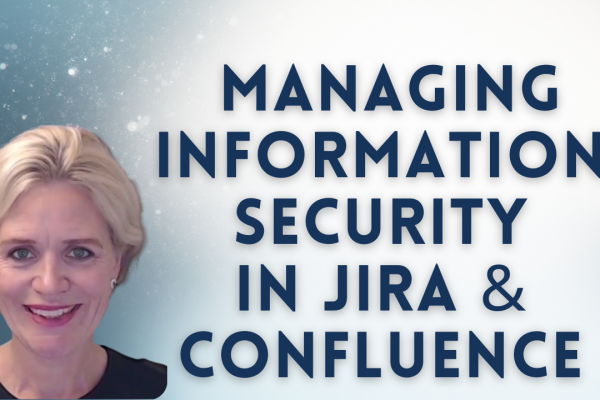Keeping your data safe is vital for every business. One way to do this is by following ISO 27001. But how can we manage these information security risks with a tool like Jira? Let’s dive in!
What is Information Security Risk Management
Information Security Risk Management is all about identifying, assessing, and managing risks to keep your data safe. Think of it like a security guard who not only spots potential threats but also takes steps to neutralize them. Here’s why it’s crucial:
At its core, Information Security Risk Management has these four steps:
- Identifying Risks: Finding potential threats to your information’s safety. These could be anything from cyber-attacks and data breaches to physical security vulnerabilities.
- Assessing Risks: Evaluating the likelihood of these risks actually happening and understanding their potential impact if they do occur. This can include financial losses, reputational damage, or operational disruptions.
- Mitigating Risks: Developing strategies to controlling the assessed risks. This could involve improving security protocols, training staff, or investing in new technology.
- Reporting & Regularly Reviewing Risks: Report risks to ensure that all stakeholders are informed of the status of the risks. Regularly reviewing risks and making sure that all information assets have been analysed, all identified risks mitigated and all necessary controls used is a vital part of information security risk management.
Why care about Information Security Risk Management?
- Data Protection: With cyber-attacks becoming more sophisticated, safeguarding business data is critical. Effective risk management means protecting sensitive information from unauthorized access and breaches.
- Trust: Customers and stakeholders need to know that their information is secure. A strong risk management framework builds trust and boosts your reputation.
- Compliance: Many industries are governed by regulations that require stringent information security practices. Adhering to these regulations helps avoid hefty fines and legal troubles.
- Business Continuity: Identifying and managing risks ensures that your business can continue to operate even if a security incident occurs. This means fewer interruptions and more stability.
- Financial Security: The cost of data breaches can be crippling. Risk management helps in minimizing these costs by preempting potential security threats and mitigating them before they cause significant damage.
In summary, Information Security Risk Management is akin to having a comprehensive insurance policy for your data and business continuity. It’s not just about ticking boxes but ensuring that you’re always a step ahead of potential threats.
Understanding ISO 27001

Think of ISO 27001 as the gold standard for information security. Officially known as ISO/IEC 27001, this standard sets out the criteria for an effective Information Security Management System (ISMS).
ISO 27001 might sound fancy, but at its core, it’s a framework. It outlines policies, processes, and controls geared towards managing information security. The standard is designed to help organizations of all sizes protect their information systematically and cost-effectively.
Why You Need ISO 27001
So, why should you care about ISO 27001? For starters, it’s about credibility and trust. In today’s world, data breaches and cyberattacks are increasingly common, and customers are more concerned than ever about how their information is handled. Achieving ISO 27001 certification reassures customers and stakeholders that your business takes information security seriously.
Moreover, it’s not just about preventing breaches. ISO 27001 helps you identify potential risks before they become actual issues. It also prepares your organization to handle security incidents efficiently if they do arise. By following this standard, companies can ensure they put the right defensive measures, known as controls, in place and maintain compliance with relevant legal and regulatory requirements.
In summary, ISO 27001 isn’t just a box-ticking exercise. It’s a strategic asset. By adopting the standard, businesses can protect their information, maintain customer trust, and create a robust framework that supports continuous improvement in information security practices.
Jira for Information Security Risk Management?
So, why should you consider Jira for handling information security risks? Simple: it’s a no-nonsense tool that gets the job done. First off, ease of use is key. Jira has a straightforward, user-friendly interface that even team members with minimal tech experience can navigate effortlessly.
Next, integration. Jira isn’t a loner; it plays well with other tools. Whether you’re using Confluence for documentation, Slack for communication, or any other project management staples, Jira fits right in. It streamlines workflows, ensuring that all your risk management efforts are centralized and cohesive.
Also, customization is a big win. Your business isn’t a one-size-fits-all operation, and neither should your risk management strategy be. Jira’s customization capabilities allow you to tailor workflows, issue types, and fields to align with your specific risk management processes. This means you can create a risk management setup that’s unique to your organizational needs without jumping through hoops.
Lastly, use dedicated apps that are built on Jira add extra functionality to really make risk management shine. That’s where the SoftComply Risk Manager Plus app comes in. SoftComply Risk Manager Plus is the highest rated and most advanced risk management app on Jira Cloud. It includes a dedicated module for Information Security Risk Management that supports compliance with ISO 27001.
For businesses serious about adhering to ISO 27001 standards, Jira offers a robust platform that’s both versatile and effective. The combination of ease, seamless integration, customization and countless number of dedicated apps makes it an ideal choice for handling information security risk management.
Setting Up Information Security Risk Management in Jira
First things first, you need to set up Jira and install the SoftComply Risk Manager Plus app.
Now that have the Risk Manager Plus app in your Jira instance, you’ll want to set it up for your organisation. Follow the steps below to set up the Information Security Risk Module in the Risk Manager Plus app.
TLDR; check out the video tutorial instead.
Risk Manager Plus for your InfoSec Risk Management
- Create a new risk management project in Jira.
- Next, choose a risk model – you can choose between a 2D or 3D risk matrix, or use RPN scores. You can customize the chosen model as needed.
- Set up your risk register. The app comes with an editable multi-sheet risk table that risk managers can work in. The app guides you through each step of the setup, making it super easy.
- Link your risk model, risk register, ISO 27001 controls and asset repositories to the newly created risk management project. You can further customize the repositories, called object registers, in the app for any organisational or risk related data that is often used in relation to risks.
- Finally, you can monitor your progress towards ISO 27001 requirements in the Dashboard and generate the Statement of Applicability directly from the app.
4 Steps to Managing InfoSec Risks in Jira

1. Identifying Risks
Once SoftComply Risk Manager Plus is set up, start identifying risks. This means listing out all your information assets and analysing what could potentially go wrong with each of them.
- Create an Asset Repository: List all your organisational information assets in the Object Register of the Risk Manager Plus app
- Customise your Risk Register: Use the editable risk table of the Risk Manager Plus app to log all the potential risks for each chosen asset. This way, you have everything in one place.
- Describe Each Risk: For each risk you register, provide a description. Explain what it is and how it might affect your business.
2. Assessing Risks
With your risks identified, the next step is to assess them. You need to know how likely each risk is to occur and what the impact might be.
- Likelihood: Determine the probability of each risk happening. Is it very likely or just a remote possibility?
- Impact: Assess the potential damage. Would it be a minor inconvenience or a major disaster?
- Risk Score: With the combination of the likelihood and impact, the app will calculate the risk score based on your chosen risk model. This score helps prioritize which risks need immediate attention.
3. Mitigating Risks
Knowing the critical risks is one thing; controlling them is another.
- Mitigation: For each major risk, develop a plan to reduce or eliminate it. This could involve adding extra security measures, changing processes, or providing additional training. You can also use the ISO 27001 library of controls that is included in the Risk Manager Plus app to choose an appropriate mitigation action for your risks.
- Action Assignments: Assign specific tasks to your team members. Make sure everyone knows what they need to do to control the risks.
4. Reporting & Regularly Reviewing Risks
Finally, you need to make sure you’re continuously improving your risk management processes.
- Regular Reports: Generate risk reports directly from the Risk Manager Plus app, including the Statement of Applicability for ISO 27001 audits.
- Continuous Monitoring: Regularly review and update your risk register to keep track of how things are progressing and whether any new risks have emerged.
By following these steps in Jira with the dedicated Information Security module in the Risk Manager Plus app, you can set up a solid framework for managing information security risks, aligned with ISO 27001 standards. This not only keeps your data safe but also builds trust with your customers.
Conclusion
Using Jira for information security risk management is a smart move. It’s easy to use, integrates well with other tools, and can be customized to fit your needs. By following ISO 27001 standards within Jira, businesses can keep their data safe and maintain trust with their customers.
Remember, it’s a continuous process. Keep assessing and managing risks to keep your business strong!
👉 Try out the Risk Manager Plus for free for 30 days – https://marketplace.atlassian.com/apps/1219692/softcomply-risk-manager-plus-top-risk-management-in-jira?hosting=cloud&tab=overview
👉 Schedule a product demo to learn more about managing information security risks in Jira – https://calendly.com/softcomply/softcomply-risk-manager-demo





